Spider plants, with their striking arching leaves and hardy nature, are a favorite among indoor gardeners. However, one common issue that can be quite perplexing is the yellowing of their leaves. If your spider plant is looking a bit worse for wear, don’t worry! This comprehensive guide will help you diagnose and remedy the problem.

Understanding the Cause
Spider plants can develop yellow leaves for several reasons, each linked to their growing conditions. Let’s explore some of the most common culprits:
Overwatering
Spider plants are prone to root rot if they receive too much water. Signs of overwatering include yellowing leaves, a soggy soil environment, and a musty smell from the pot. Ensure your spider plant’s soil is well-draining and that you water it only when the top inch of the soil is dry.
Underwatering
Conversely, underwatering can also cause yellow leaves. If the soil is bone-dry and the leaves feel brittle, your plant is likely thirsty. Regular, moderate watering is key to keeping your spider plant happy.
Poor Lighting Conditions
Spider plants thrive in bright, indirect light. If they are placed in too much direct sunlight or in a dark corner, their leaves may yellow. Find a balance by positioning your plant near a window with filtered sunlight.
Nutrient Deficiency
A lack of essential nutrients can lead to yellowing leaves. Spider plants need a balanced fertilizer every couple of months during the growing season to maintain their vibrant green hue.
Pest Infestations
Spider plants are occasionally targeted by pests like spider mites and aphids. These tiny invaders can sap the plant’s vitality, leading to yellowing. Regularly inspect your plant and treat any infestations with appropriate natural or chemical remedies.
How to Revive Your Yellowing Spider Plant
Now that we’ve identified the potential causes, let’s look at how to nurse your spider plant back to health:
Adjust Watering Habits
If overwatering was the issue, reduce the frequency of watering and ensure proper drainage. If underwatering, increase the amount of water while avoiding letting the plant sit in waterlogged soil.
Optimize Light Exposure
Move your spider plant to a spot with bright, indirect light. Avoid placing it in direct sunlight, which can scorch the leaves, or in very low light, which can cause yellowing.
Fertilize Appropriately
Use a balanced, water-soluble fertilizer and follow the instructions on the label. Avoid over-fertilizing, as this can damage the plant’s roots.
Combat Pests
For a mild infestation, a strong spray of water can dislodge many pests. For more persistent problems, consider insecticidal soap or neem oil as organic solutions.
Repot If Necessary
If the plant is root-bound or if the soil has become compacted and poorly draining, repotting might be the best solution. Choose a pot with good drainage and fresh, well-draining soil mix.
Conclusion
Yellowing leaves on your spider plant are a sign that it needs a bit of extra care and attention. By understanding the possible causes and taking the right steps to address them, you can restore your spider plant to its lush, green glory. Keep an eye on its conditions, adjust as needed, and enjoy the beauty that a healthy spider plant brings to your home!
